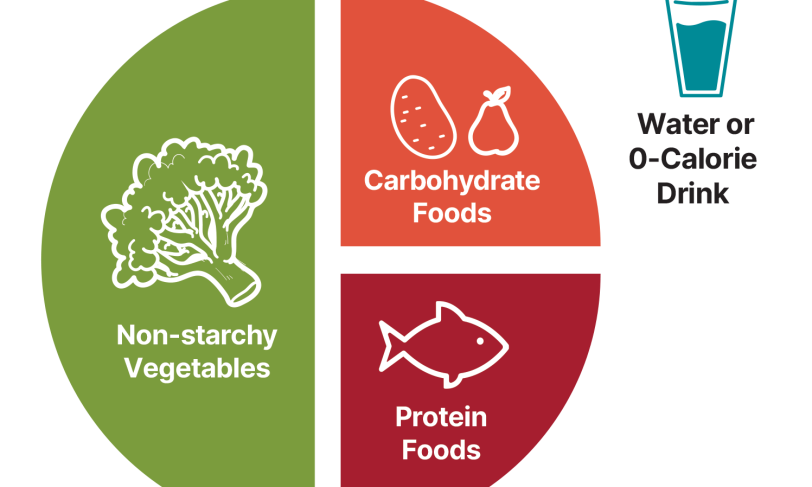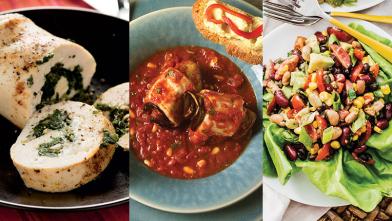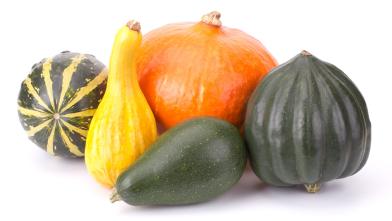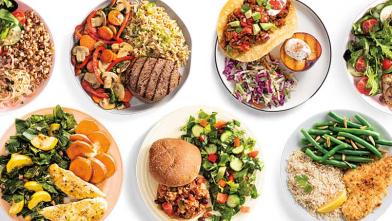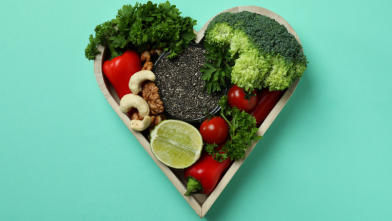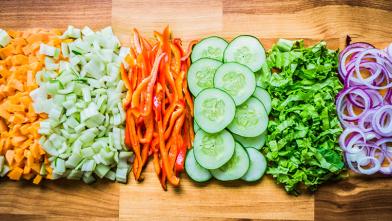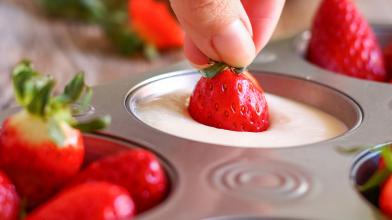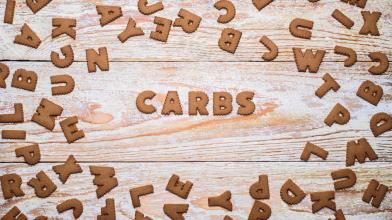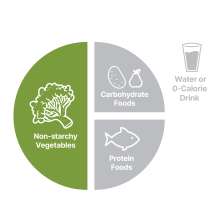
The Diabetes Plate is the easiest way to create healthy low-carb meals that can help you manage your blood glucose (blood sugar). Using the Diabetes Plate, you can create a meal with a healthy balance of vegetables, protein, and carbs—without any counting, calculating, weighing, or measuring. All you need is a plate!
To start out, you need a plate that is nine inches across. The size of our plate is what controls the size of our portions. If your dinner plates are larger than nine inches, try using a smaller salad or dessert plate for your meals. Or, if your dinner plates have a lip or artwork along the edge, use that as a border for filling your plate if the area inside the border is 9 inches across.
Now that you have the right plate, it’s time to fill it!
1. Fill 1/2 your plate with nonstarchy vegetables.

Non-starchy vegetables are lower in carbs, so they don’t raise your blood glucose very much. They are also higher in fiber, vitamins, and minerals—making them an important part of a healthy diet and what some people call “superstar foods”. Filling half your plate with non-starchy vegetables means you will get plenty of servings.
Examples of non-starchy vegetables:
- Asparagus
- Broccoli
- Cauliflower
- Brussels Sprouts
- Cabbage (green, red, napa, Chinese)
- Bok choy
- Carrots
- Cauliflower
- Celery
- Cucumber
- Eggplant
- Jicama
- Leafy greens such as kale, collards, mustard greens, and Swiss Chard
- Mushrooms
- Nopales (cactus)
- Okra
- Onions
- Leeks
- Green beans, pea pods, snow peas, and sugar snap peas
- Peppers such as bell peppers and hot peppers (jalapeño, poblano, and others)
- Salad greens such as lettuce, spinach, arugula, endive, and other salad mixes
- Squash such as zucchini, yellow squash, chayote, or spaghetti squash
- Radish or daikon
- Tomatoes
- Tomatillos
2. Fill 1/4 of your plate with lean protein foods
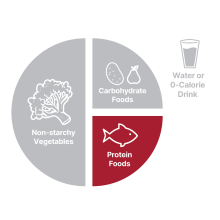
Foods high in protein such as fish, chicken, lean beef, soy foods, and cheese are all considered protein foods.
Proteins foods (especially those from animal sources) usually contain saturated fat, which can increase your risk of heart disease. Lean proteins are lower in both fat and saturated fat, making them a healthier choice.
Keep in mind that some plant-based protein foods (like beans and legumes) are also high in carbohydrates.
Examples of lean protein foods include:
- Chicken, turkey, and eggs
- Fish like salmon, cod, tuna, tilapia, and swordfish
- Shellfish like shrimp, scallops, clams, mussels, and lobster
- Lean beef cuts such as chuck, round, sirloin, flank, and tenderloin
- Lean pork cuts such as center loin chop and tenderloin
- Lean deli meats
- Cheese and cottage cheese
Plant-based sources of protein:
- Beans, lentils, hummus, and falafel
- Nuts and nut butters
- Edamame
- Tofu and tempeh
- Plant-based meat substitutes
3. Fill 1/4 of your plate with carbohydrate foods

Foods that are higher in carbs include whole grains, starchy vegetables, beans and legumes, fruit, yogurt, and milk. These foods have the largest effect on blood glucose.
Limiting your portion of carbohydrate foods to one-quarter of your plate can help keep blood glucose from rising too high after meals.
Examples of carbohydrate foods:
- Whole grains such as brown rice, bulgur, oats/oatmeal, polenta, popcorn, quinoa, and whole grain products (bread, pasta, and tortillas)
- Starchy vegetables such as corn, acorn squash, butternut squash, green peas, parsnips, plantains, potatoes, pumpkins, and sweet potatoes/yams
- Beans and legumes such as black, kidney, pinto, and garbanzo beans and lentils
- Fruits and dried fruit
- Dairy products like milk, yogurt, and milk substitutes (e.g., soy milk)
4. Choose water or a low-calorie drink
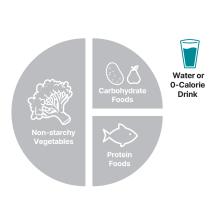
Water is the best choice because it contains no calories or carbs and has no effect on blood glucose. Other zero- or low-calorie drink options include:
- Unsweetened tea (hot or iced)
- Unsweetened coffee (hot or iced)
- Sparkling water/club soda
- Infused water or sparkling water without added sugar
- Diet soda or other diet drinks
Looking for more ideas? Check out this article for more tips and recipes for meal planning with the Diabetes Plate.
What about combination foods?
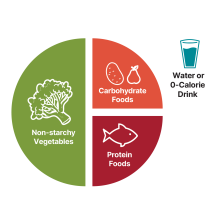
Our meals don’t always fit into the sections of the Diabetes Plate. Many dishes—like soups, casseroles, sandwiches, pizza, and pasta—combine the different food types together. You can still use the Diabetes Plate when you prep and serve these types of foods. Just identify the different foods in the dish and think about where they would fit in the Plate.
Try to prepare combination dishes with proportions that follow the Diabetes Plate. So, to build a pizza using the Diabetes Plate, choose a thin or vegetable-based crust to reduce the portion of carbs and top it with lots of vegetables instead of meat (or choose a lean meat). Stick to just one or two slices and serve with a side salad so half your meal is non-starchy vegetables.
The Diabetes Plate is a great place to start to create balanced low-carb meals. You can work with your dietitian or diabetes care and education specialist to find the meal pattern that works best for you and your fits specific health goals.
Need help planning meals? Create a free account with Diabetes Food Hub to start saving recipes and using our meal planner!
Support the ADA
If you found this article helpful in your diabetes journey, please consider supporting the American Diabetes Association (ADA). The ADA is the leading voluntary health organization fighting to bend the curve on the diabetes epidemic and help people living with diabetes thrive. With your financial support, we can advance our mission to prevent and cure diabetes and to improve the lives of all people affected by diabetes. Learn more about how you can support the ADA.
